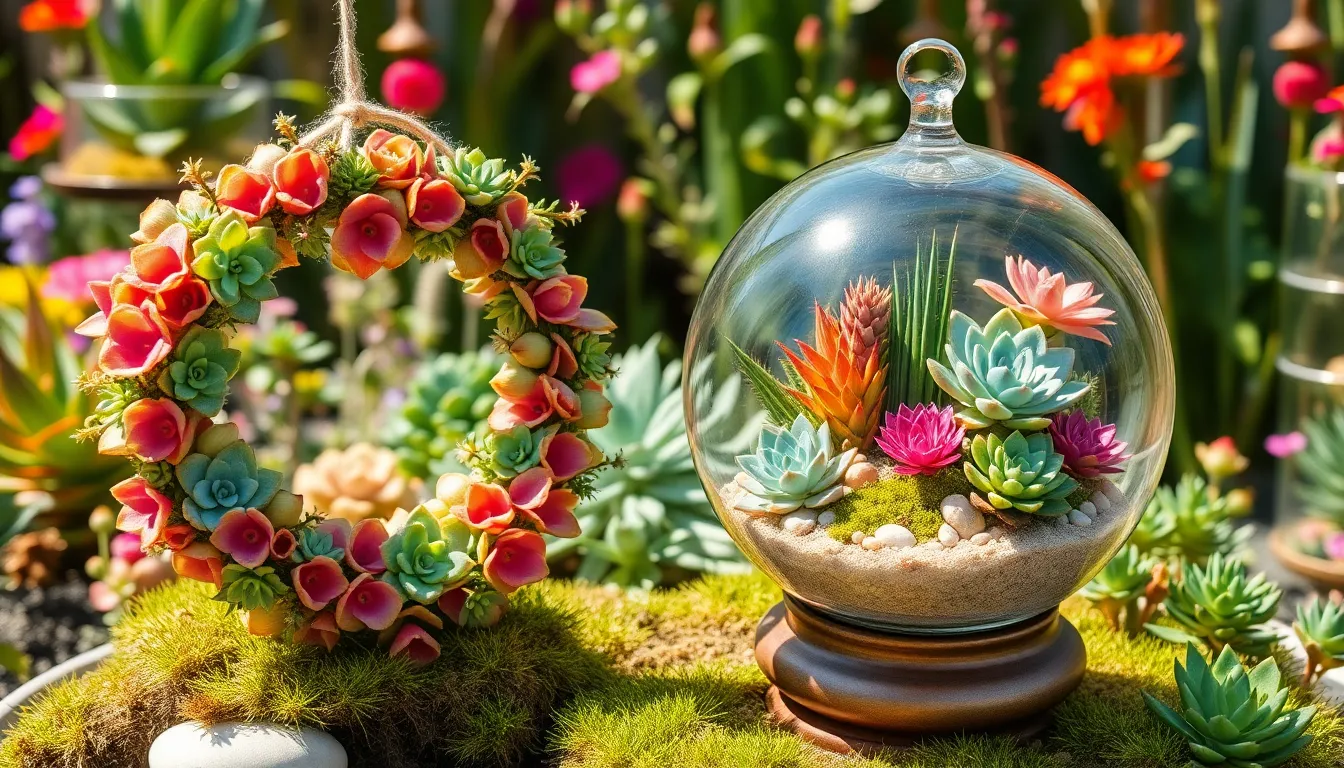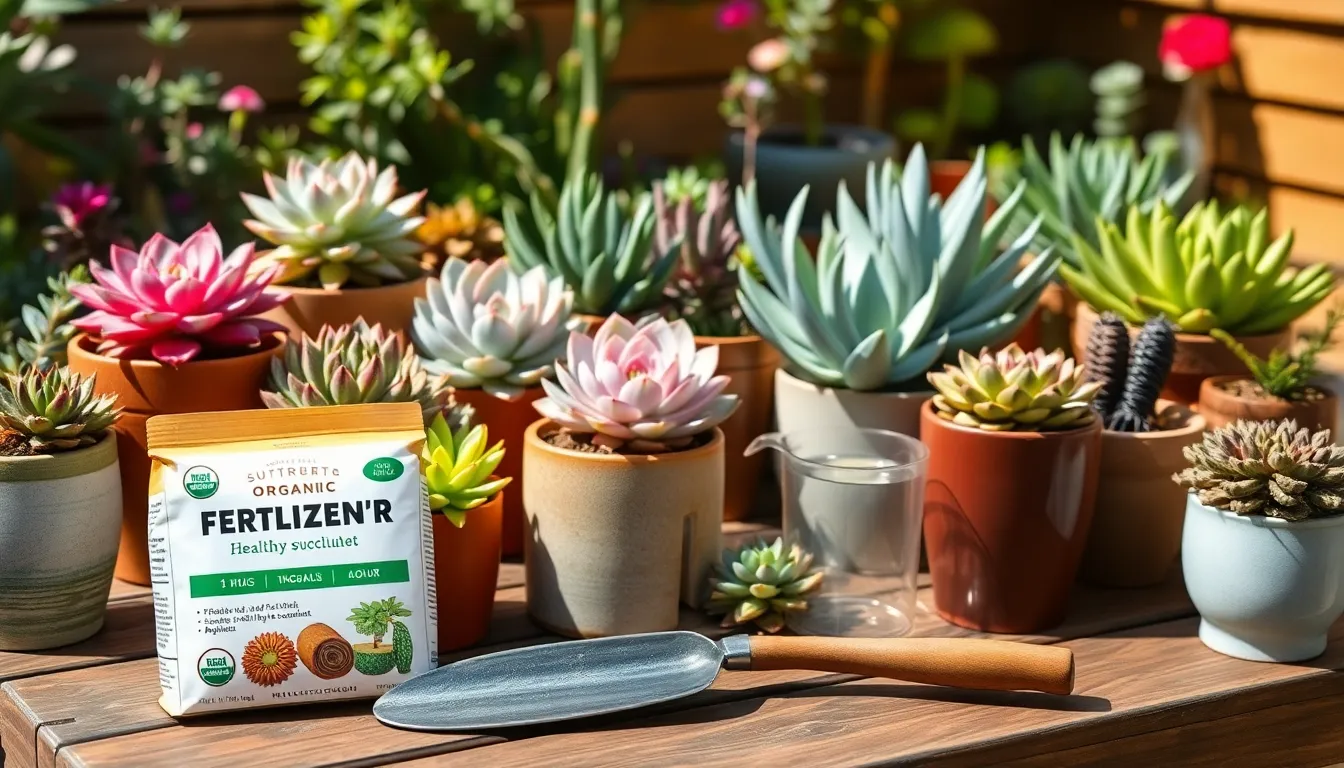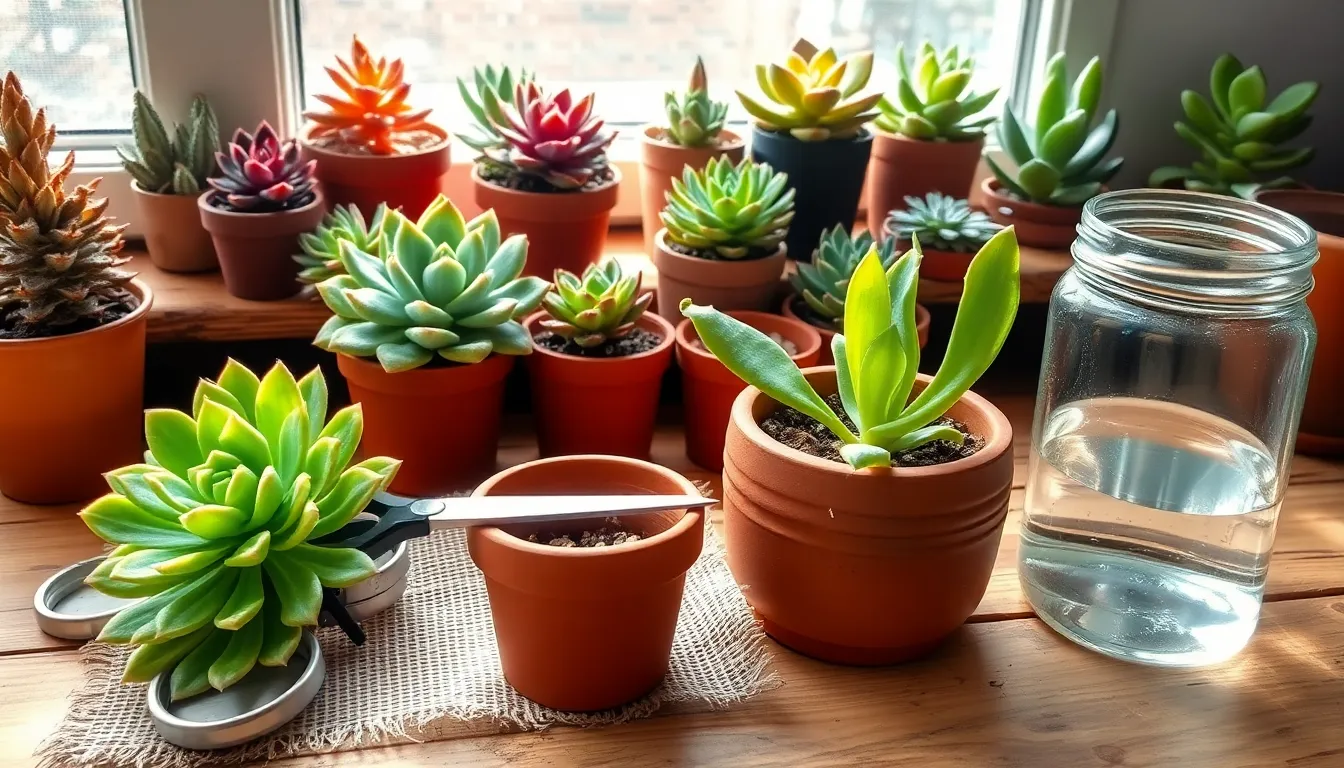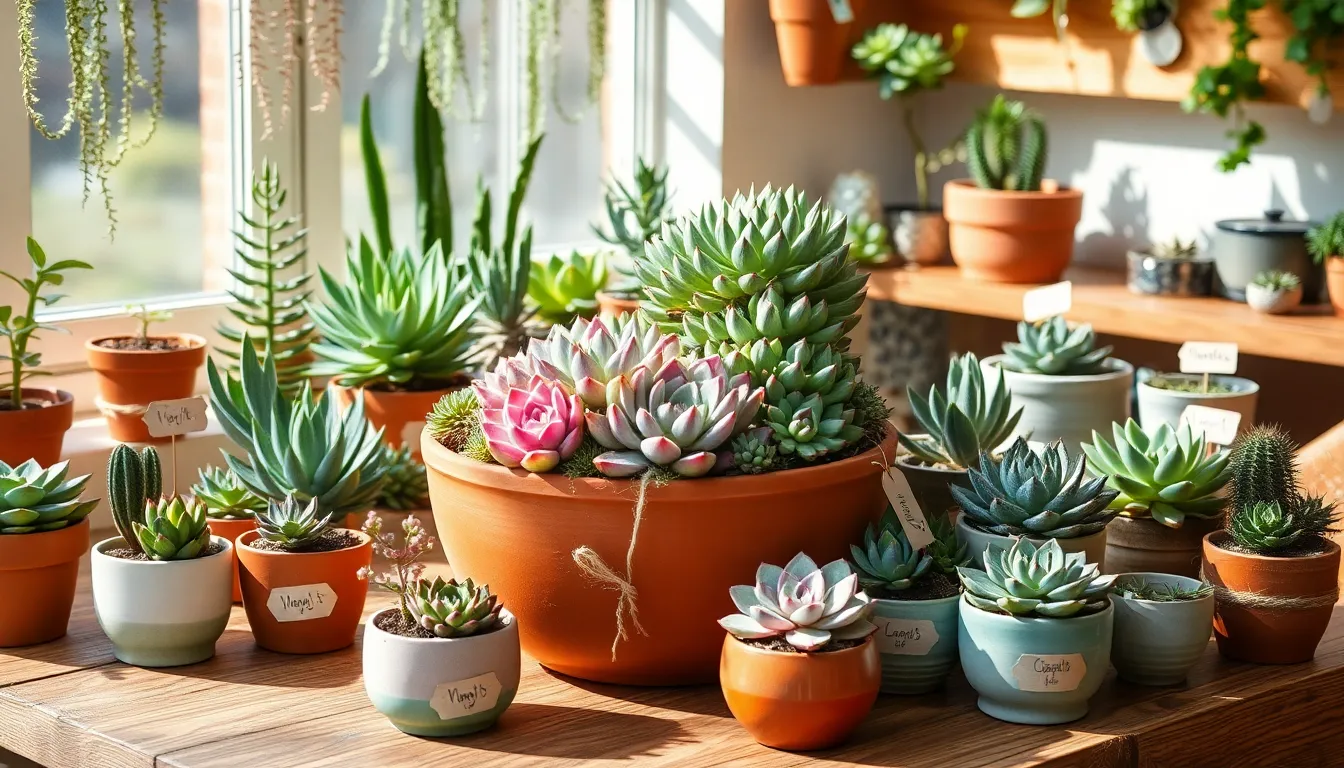Welcome to the delightful world of succulents—where beauty meets resilience in a harmonious blend of vibrant colors and intriguing textures. Whether you’re just beginning your gardening journey or you’ve been nurturing plants for years, succulents offer a versatile canvas for creativity, inviting everyone to experiment and explore.
Succulents have garnered a well-deserved reputation for being both easy to care for and endlessly adaptable, making them the perfect candidates for a variety of DIY projects. In this article, you’ll discover ten inspiring ways to incorporate these charming plants into your home and garden, each idea designed to spark your imagination and enhance your living space.
From crafting stunning terrariums to designing eye-catching living walls, you’ll learn how to transform simple materials into extraordinary displays, all while enjoying the low-maintenance benefits succulents provide. So grab your gardening gloves and let’s dive into a world of creative possibilities, where every project promises to be as rewarding as it is beautiful.
Creating Succulent Terrarium Gardens

Creating a succulent terrarium garden is a delightful way to bring a touch of greenery into your home. Begin by selecting a clear glass container, which allows you to observe the beauty of your plants and the layers within.
It’s essential to use a well-draining soil mix specifically formulated for succulents and cacti. This type of soil helps prevent root rot, which is a common issue in enclosed environments.
Layering your terrarium correctly is crucial for the health of your succulents. Start with a base of small stones or gravel to ensure proper drainage, followed by a layer of activated charcoal to keep the environment fresh and prevent mold.
When arranging your succulents, consider their growth habits and light requirements to create a visually appealing and harmonious display. Position taller plants at the back and smaller ones in the front to create depth and dimension.
Watering a succulent terrarium requires a light touch, as overwatering can be detrimental. Aim to water sparingly, using a spray bottle to lightly moisten the soil once every two to three weeks, depending on humidity levels.
For those looking to add a touch of creativity, incorporate decorative elements like colored sand, pebbles, or small figurines. These additions can enhance the aesthetic appeal while personalizing your terrarium garden.
Crafting Succulent Wall Art
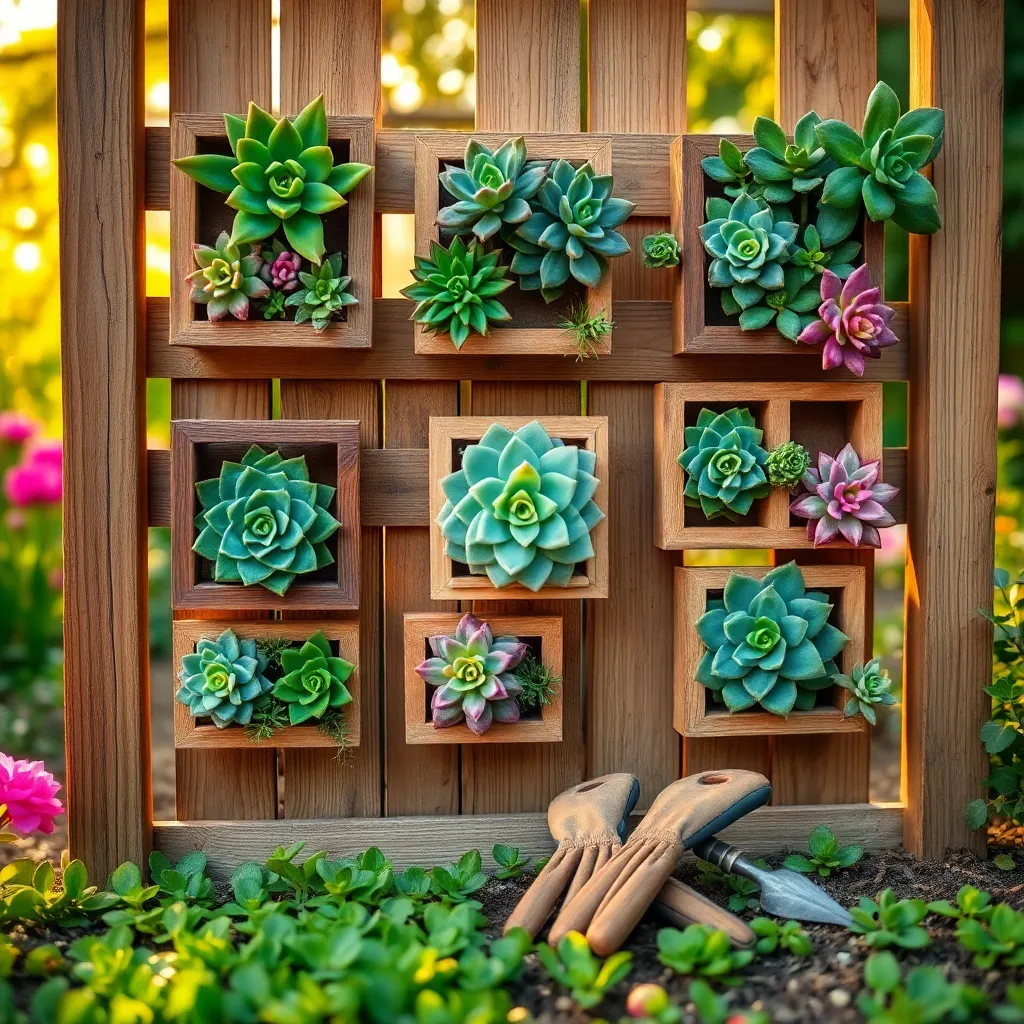
Succulent wall art is a creative way to bring greenery into your home, combining aesthetic appeal with the low-maintenance nature of succulents. Begin by selecting a sturdy frame with a backing that can support soil and plants; a shadow box or an old picture frame with depth works well.
To create a base, line the frame with landscape fabric or a coconut coir liner, which will help retain soil and moisture. Use a well-draining succulent soil mix, which typically includes sand, perlite, and peat moss, to fill the frame and provide optimal growing conditions.
Next, arrange your succulents in a visually pleasing pattern, ensuring each plant has enough space to grow. Choose a variety of succulents like Echeveria, Sedum, or Crassula to add texture and color; these types thrive in similar conditions and create a harmonious display.
Water your succulent wall art sparingly, allowing the soil to dry out completely between waterings to prevent root rot. Position your finished piece in a location with indirect sunlight, such as a bright room or a shaded patio, to provide the plants with adequate light without scorching them.
Designing Succulent Centerpieces
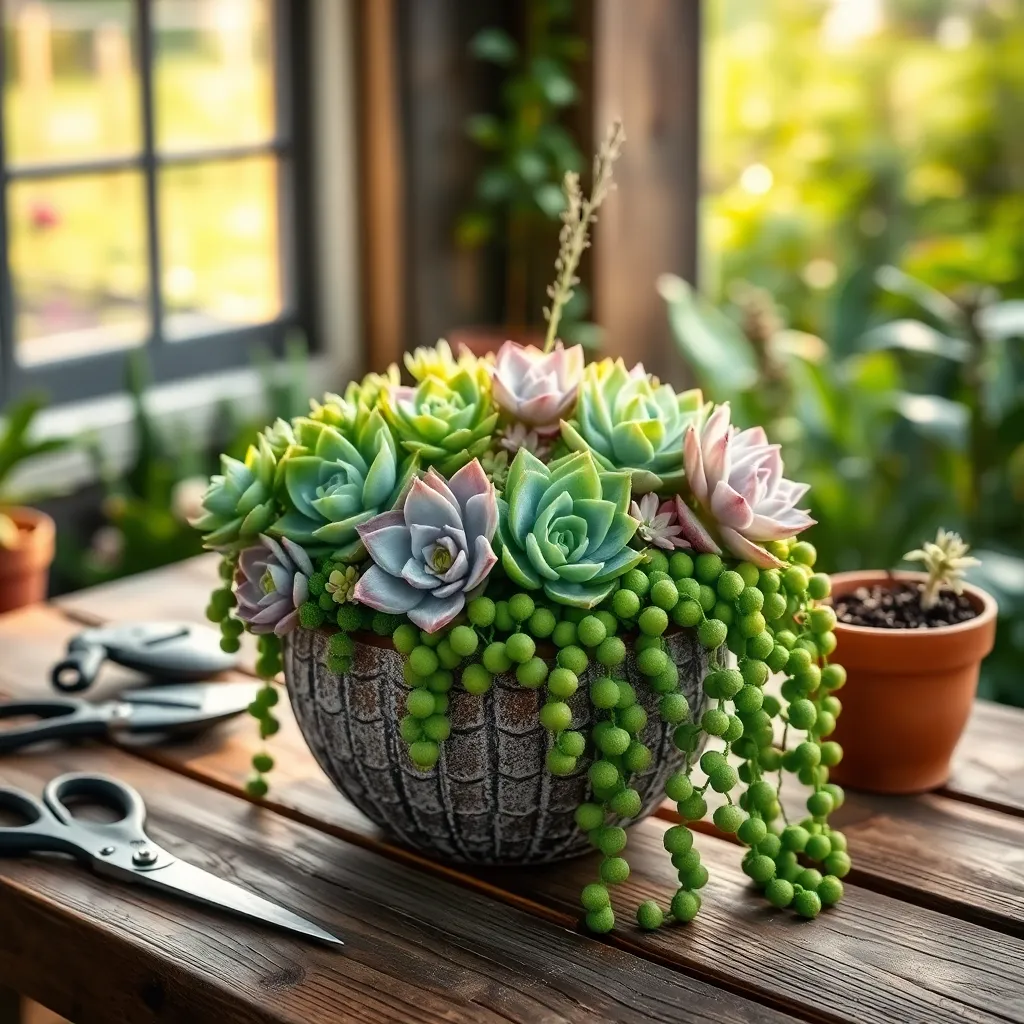
Creating a succulent centerpiece is a delightful way to bring natural beauty into your home. Begin by selecting a shallow container with drainage holes, as succulents prefer well-draining environments.
Arrange a variety of succulents in the container, considering the color and texture of each plant for aesthetic appeal. For a balanced look, place taller succulents like Echeveria in the center and smaller ones like Sedum around the edges.
Use a special cactus and succulent soil mix to ensure optimal drainage and root health. This type of soil typically contains sand or perlite, which helps prevent root rot by allowing excess water to escape quickly.
Water the centerpiece sparingly, allowing the soil to dry out completely between waterings, usually every two to three weeks. Keep the centerpiece in a spot that receives several hours of bright, indirect sunlight each day to maintain healthy growth.
For a more advanced touch, incorporate decorative elements like stones or moss between the succulents. These additions not only enhance the visual interest but also help retain moisture in the soil.
Building Succulent Fairy Gardens
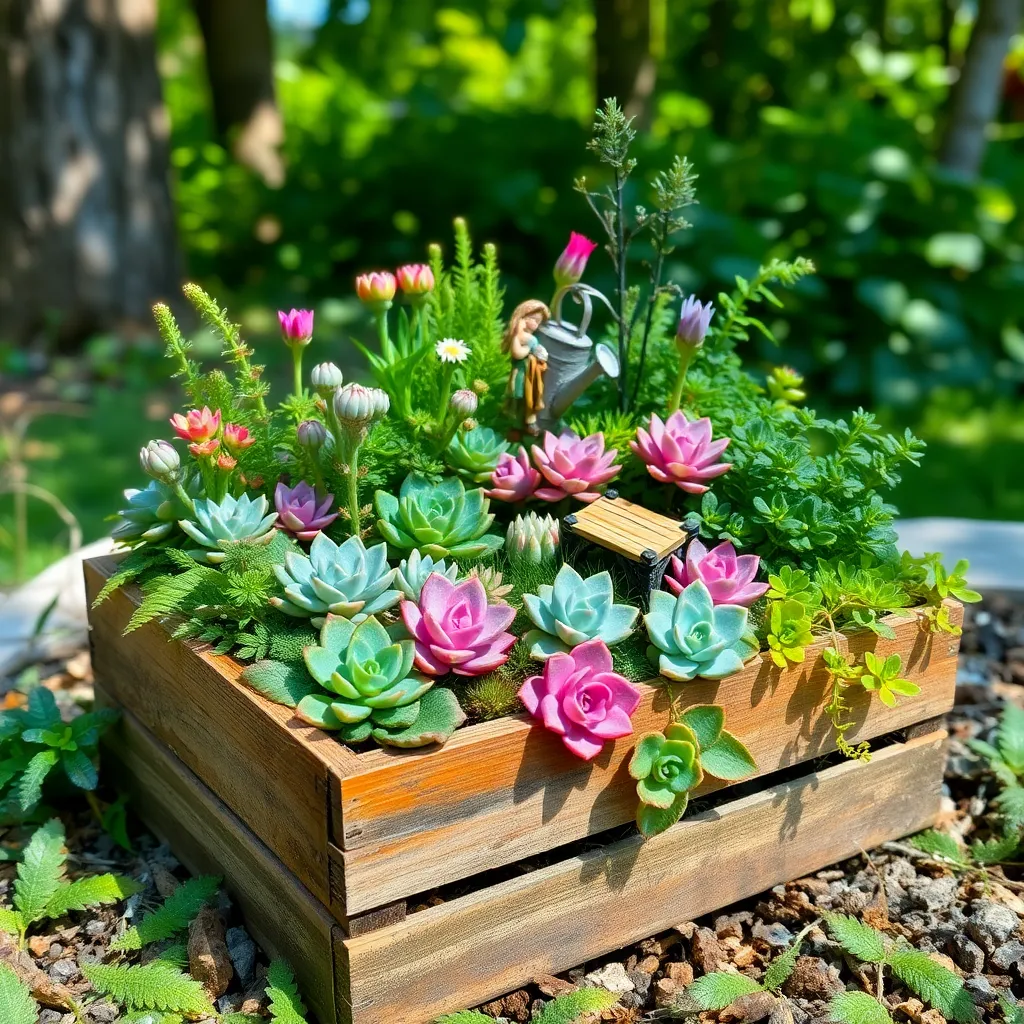
Creating a succulent fairy garden is a delightful way to combine the charm of miniature landscapes with the easy care of succulents. Start by selecting a shallow container with drainage holes to prevent waterlogging, which is crucial for these drought-resistant plants.
Choose a well-draining soil mix, ideally a sandy or gritty blend specifically formulated for succulents and cacti. This ensures that your succulents have the perfect environment to thrive, allowing for proper air circulation around their roots.
Position your container in a spot where it receives bright, indirect sunlight, as direct sun can scorch the leaves. Water sparingly, allowing the soil to dry out completely between waterings, especially during dormancy periods in winter.
To add an element of whimsy, incorporate miniature furniture, figurines, or small pathways using pebbles or sand. For advanced gardeners, consider adding a small water feature or lighting to enhance the magical atmosphere of your fairy garden.
Making Succulent Wreaths
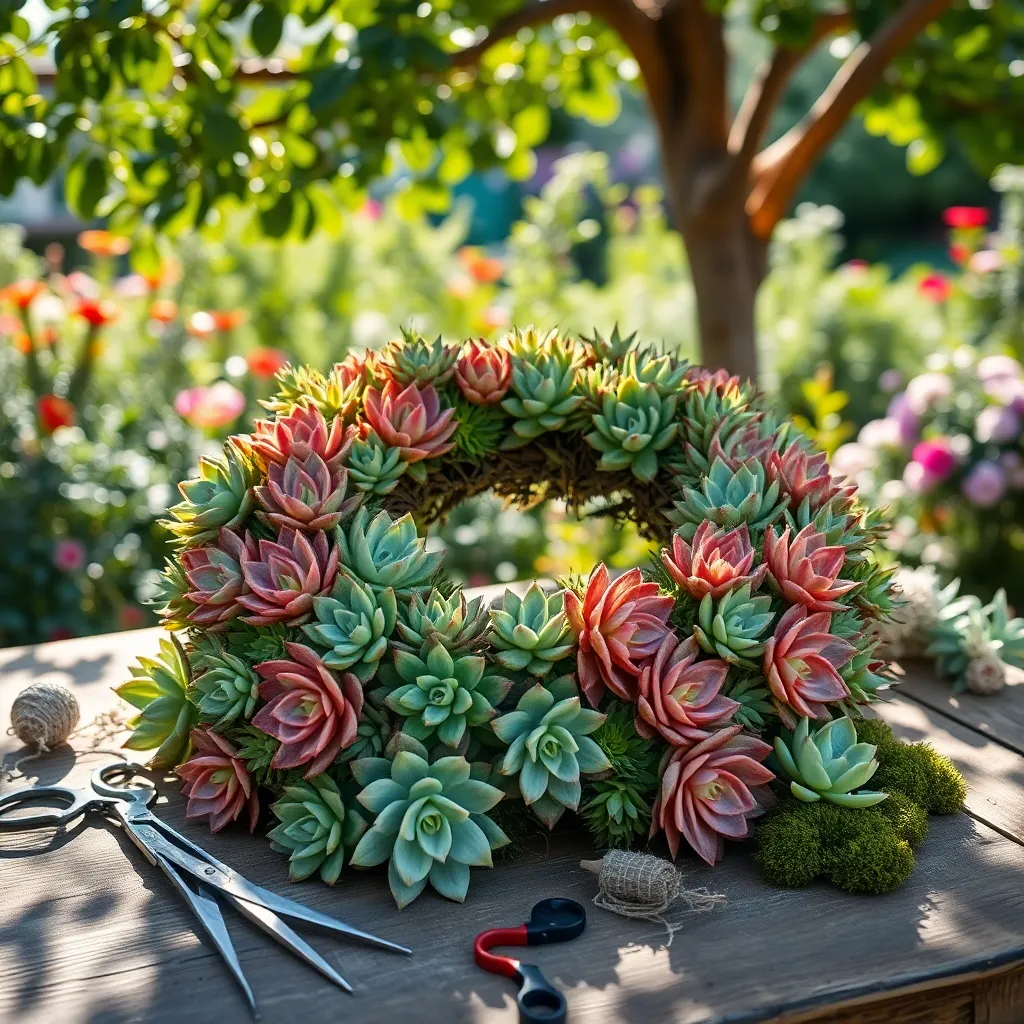
Creating a succulent wreath is a delightful way to bring the beauty of these resilient plants into your home decor. Start by selecting a sturdy frame, such as a wire wreath form, which can support the weight of the soil and plants.
To ensure your wreath stays healthy, use a well-draining soil mix, such as one specifically designed for cacti and succulents. Moisture is the enemy of succulents, so avoid using regular potting soil that retains too much water.
When choosing succulents, opt for a variety of shapes and colors to create visual interest. Popular choices include Echeveria, Sedum, and Sempervivum, which are easy to care for and thrive in similar conditions.
After planting, water the wreath lightly and allow it to dry out completely between waterings. As succulents prefer bright, indirect light, hang your wreath in a location that receives plenty of sunlight without direct exposure.
Regular maintenance involves gently trimming overgrown plants and removing any dead leaves. For advanced gardeners, consider incorporating trailing succulents like String of Pearls to add texture and dimension to your wreath.
Succulent Planter Transformations
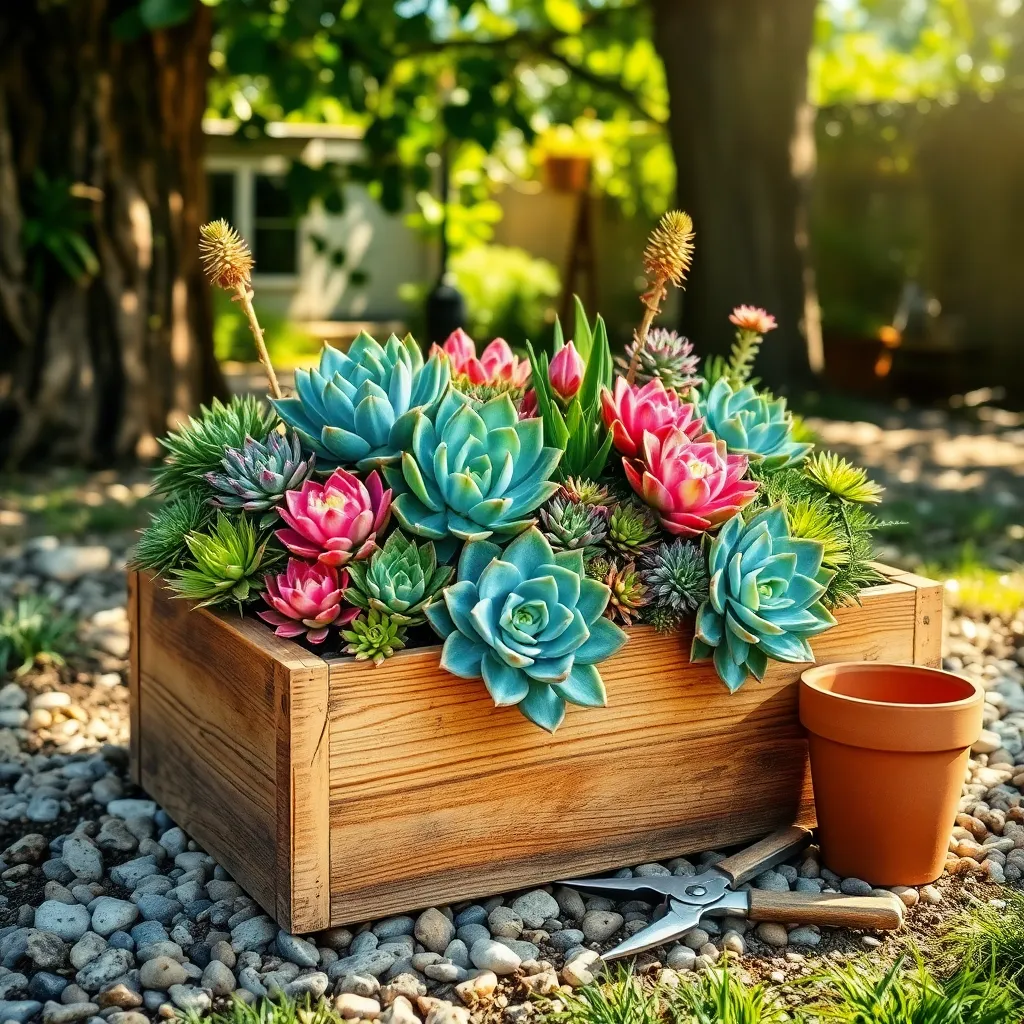
Transforming a plain container into a stunning succulent planter can be both rewarding and straightforward. Begin by choosing a container with drainage holes to prevent waterlogged roots, which are a common issue with succulents.
Next, select a well-draining soil mix specifically formulated for succulents and cacti. This type of soil typically includes a combination of sand, perlite, and potting soil, ensuring the roots receive adequate aeration.
Layer the bottom of the container with small stones or gravel to further enhance drainage. Arrange your succulents in the planter, combining various shapes and colors for visual appeal, while ensuring each plant has ample space to grow.
Once planted, position the container in a location receiving bright, indirect sunlight. Succulents thrive in sunlight but can suffer from sunburn if exposed to harsh direct rays for prolonged periods.
Water your succulent planter sparingly, allowing the soil to dry out completely between waterings to mimic their natural arid environment. During the growing season, generally spring and summer, consider feeding your succulents with a diluted liquid fertilizer every few weeks to promote lush growth.
For those looking to experiment further, try incorporating larger stones or decorative elements into the planter design for a personalized touch. With these tips, you’ll create a vibrant succulent planter that not only enhances your space but also becomes a testament to your gardening skills.
Upcycling with Succulent Arrangements
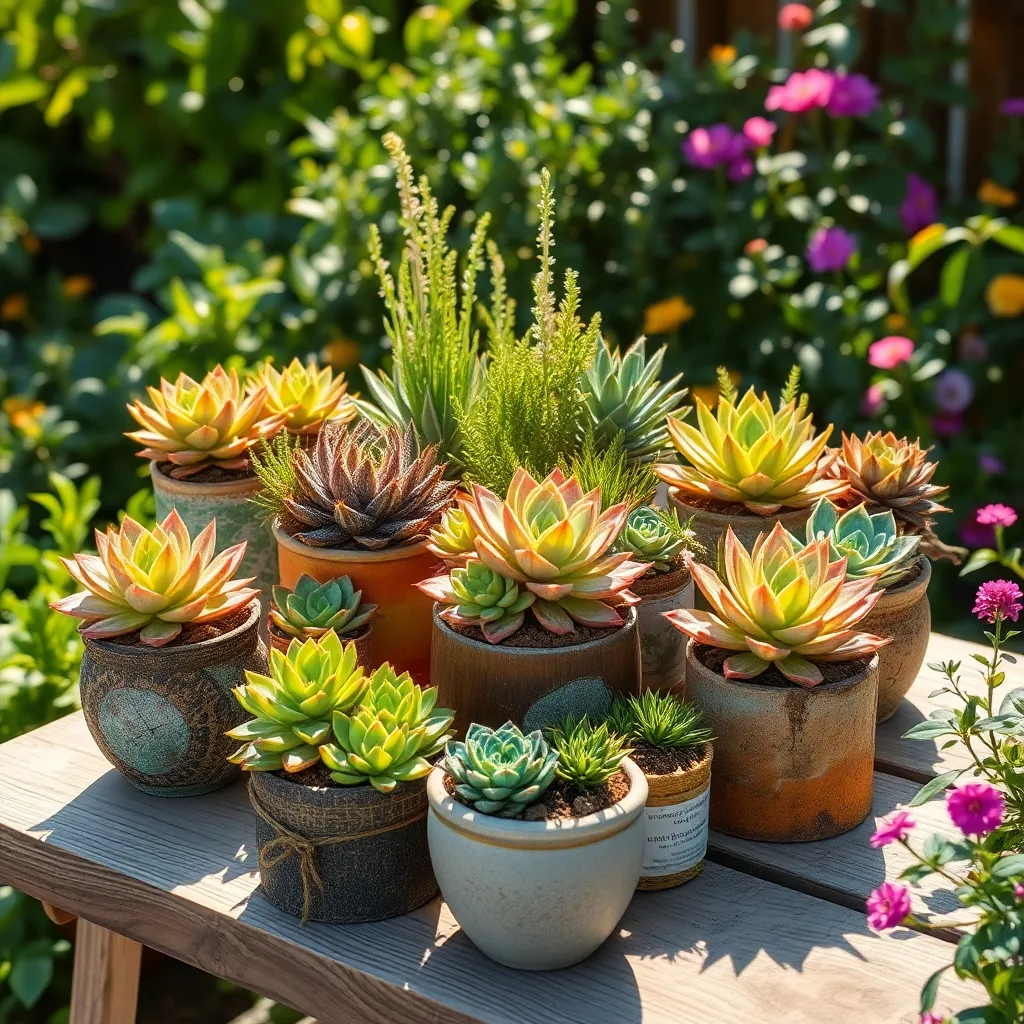
Upcycling items into succulent arrangements not only gives new life to old objects but also provides a creative outlet for gardeners. Start by selecting containers like old tea tins, wooden crates, or even broken ceramics—anything that can hold soil and has drainage potential.
Before planting, ensure that your chosen container has adequate drainage to prevent root rot. Drill holes if necessary, or add a layer of gravel or small stones at the bottom to facilitate excess water flow.
When arranging your succulents, consider using a well-draining soil mix made specifically for cacti and succulents. These plants thrive in soil that allows water to move through quickly, preventing overwatering, which is a common issue with upcycled containers.
Succulents prefer bright, indirect sunlight, making them ideal for sunny spots indoors or a shaded patio. Water sparingly, allowing the soil to dry out completely between waterings, which might mean only once every few weeks, depending on the humidity and temperature of your environment.
DIY Succulent Vertical Gardens

Creating a DIY succulent vertical garden is a fantastic way to save space and add a unique visual element to any area. Start by choosing a sturdy frame or planter that can be mounted on a wall, ensuring it has adequate depth for the succulents’ roots.
To assemble your vertical garden, use a soil mix specifically designed for succulents, which typically includes sand or pumice for improved drainage. Proper drainage is crucial, as succulents are prone to root rot if they sit in waterlogged soil.
When planting, arrange your succulents tightly to ensure they stay securely in place, as well as to create a lush, full appearance. Select a variety of colors and shapes to make your vertical garden visually appealing and dynamic.
Place your vertical garden in a spot that receives plenty of bright, indirect sunlight, as succulents thrive in well-lit environments. Depending on the climate, water your vertical garden every couple of weeks, allowing the soil to dry out completely between waterings.
- Choose succulent varieties such as Echeveria, Sedum, or Crassula that are known for their durability and visual interest.
- Use a wire mesh or chicken wire across the frame to help hold the soil and plants in place.
- Consider adding a slow-release fertilizer to the soil to provide nutrients over time.
For advanced gardeners, incorporating a drip irrigation system can ensure consistent moisture levels without the risk of overwatering. Regularly check for pests such as mealybugs, which can be controlled with insecticidal soap if needed.
Innovative Succulent Gift Ideas
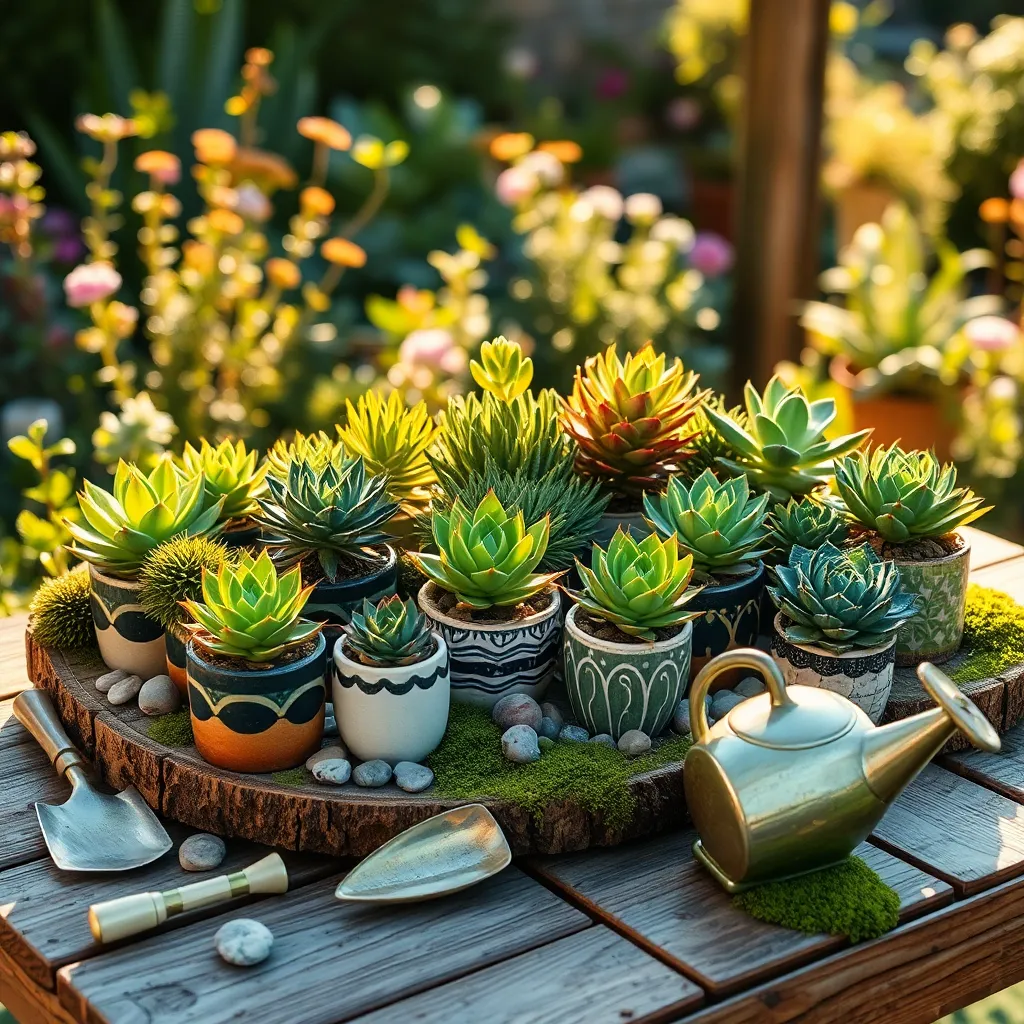
Gifting succulents is a delightful way to share the joy of gardening. Creating a succulent terrarium is an ideal project that combines creativity with nature. Start with a glass container such as a bowl or jar, ensuring it has a wide opening for easy access. Layer the bottom with pebbles for drainage, followed by a layer of activated charcoal to keep the environment fresh.
Next, add a layer of succulent soil mix, which is well-draining and essential for these drought-tolerant plants. Choose small succulents like Echeveria or Haworthia that fit comfortably within the space. For an advanced touch, incorporate decorative elements like colored sand or small figurines to personalize the gift.
Watering is key to maintaining a healthy terrarium. Water sparingly, ensuring the soil is dry between waterings, as succulents are prone to root rot if overwatered. A light misting every two weeks is generally sufficient, depending on your climate. For beginners, a tip is to use a spray bottle to control the amount of water applied.
Another innovative idea is to create succulent wreaths, which make stunning, living gifts. Use a metal wreath form filled with sphagnum moss as your base. Secure the moss with floral wire, then cut small holes to insert succulent cuttings. For best results, allow the wreath to lay flat for a few weeks so the cuttings can root properly before hanging.
Miniature Succulent Landscapes
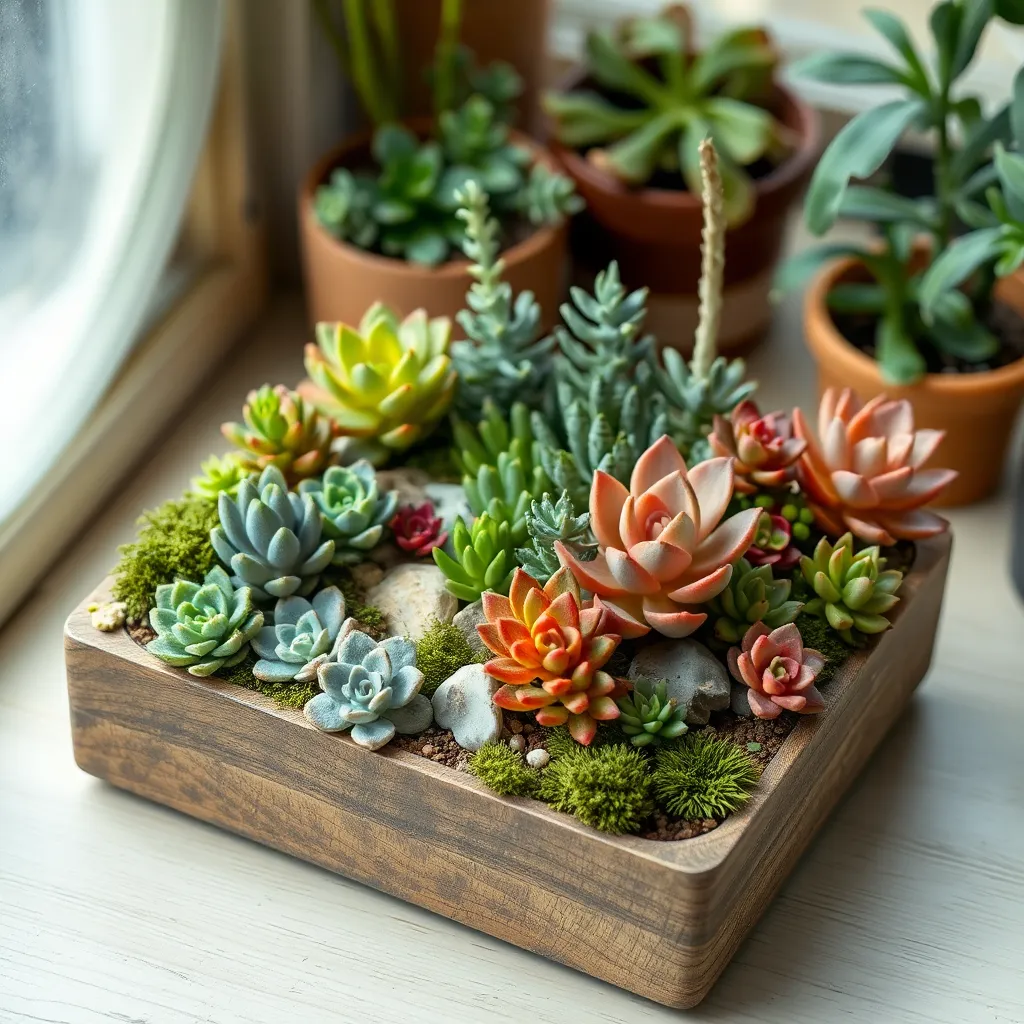
Creating a miniature succulent landscape is a delightful way to express your creativity while enhancing your gardening skills. Whether you’re a beginner or an experienced gardener, these small-scale gardens can be tailored to fit any space, from a sunny windowsill to a tiny corner of your patio.
To start, choose a shallow container with drainage holes to prevent water accumulation. Opt for a well-draining soil mix, ideally one specifically designed for succulents and cacti, to promote healthy root growth.
When selecting succulents, consider a variety of shapes, colors, and sizes to add visual interest. Hens-and-chicks, echeverias, and jade plants are excellent options that thrive in indoor environments.
Place taller plants towards the back and smaller ones in front to create a sense of depth. Arrange them with enough space to allow for growth, as overcrowding can lead to poor air circulation and potential rot.
Water your miniature landscape sparingly, allowing the soil to dry out completely between waterings. Succulents generally require watering every two to three weeks, depending on the humidity and temperature of your environment.
For an advanced touch, incorporate decorative elements like small stones, figurines, or colored sand. These additions can elevate your landscape, transforming it into a miniature world that tells a story.
Conclusion: Growing Success with These Plants
In exploring ’10 DIY Projects Using Succulents,’ we discovered how these versatile plants can teach us about patience, nurturing, and resilience—key concepts that are vital in nurturing strong relationships. From understanding the importance of giving space with a hanging garden to recognizing the value of consistency with a succulent calendar, each project offers a unique lesson. We delved into the power of communication through creative expression, the necessity of adaptability with living walls, and the joy of shared experiences by crafting together. We also highlighted the role of appreciation, celebrating growth, and the art of simplicity in strengthening our bonds.
To put these insights into practice, why not choose one succulent project that resonates with you and share it with a loved one? This could be a beautiful start to a meaningful conversation and a shared journey of growth.
Be sure to bookmark this article for future inspiration and reference, as these lessons are timeless and invaluable. Remember, the seeds of a thriving relationship are planted with understanding and nourished with love. As you cultivate these qualities, you pave the path to lasting relationship success. Let’s grow together!

